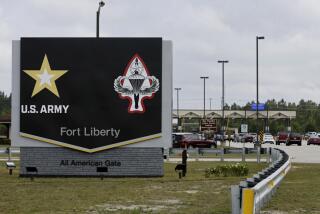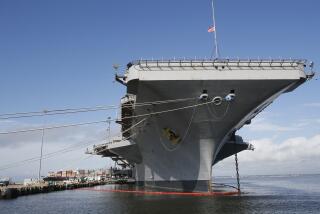Richard Ormsbee
- Share via
The Navy bases at Point Mugu and Port Hueneme have agreed to cut costs by combining some departments, including public works, fire and police. Some jobs could be lost in the process.
Although the effects of the consolidation efforts may be felt locally, they are being driven by international and national forces.
In a recent interview, Capt. Richard Ormsbee, vice commander of the Naval Air Warfare Center Weapons Division, explained why the downsizing is taking place and the strategy involved in keeping the bases open.
* * *
Question: What is driving this consolidation effort?
Answer: In the Navy, we have what we call claimancies. A claimancy is an organization that gets appropriated funding to support shore infrastructure. These include Naval Air Systems Command; Naval Sea Systems Command; commander in chief, Pacific Fleet; commander in chief, Atlantic Fleet; etc. So these are huge commands at what we call “Echelon One” levels. In the past, there have been 18 of these claimancies. What is going on in the Navy is that we are reducing the number from 18 to eight across the world.
Q: Why is this happening?
A: It happened because we need to reduce the cost of administrating the shore infrastructure. For example, Port Hueneme was administered by the Naval Facilities Command. Point Mugu was administered by Naval Air Systems Command, and any time you’ve got two separate funding streams, you’ve got two sets of comptrollers, two sets of administrators. . . . If you put them all under one command, then you can reduce the number of people and the amount of administration--what the pundits in the Washington Post like to call “fat.” But what it really is is just consolidating and streamlining management.
The other thing the Navy is doing is regionalization. This is where they will take areas such as the local one and they will say, “OK, we need to consolidate and reduce the amount of management and oversight because we are duplicating.” For example, at Port Hueneme and Point Mugu, there are two fire departments. Because the bases are only eight miles apart, you can combine management structures and have one fire chief instead of two. That’s the kind of thing regionalization is going to do.
Q: Does that mean you’ll have fewer firefighters?
A: No; this only affects management.
Q: How many people will be affected?
A: We know we’re going to regionalize and become more efficient but we don’t have the numbers because we don’t know exactly how that’s going to shake out.
Q: Downsizing military installations at any level has been relatively unpopular. Has there been any kind of attempt at the political level to avoid this? Or is this an inevitability?
A: The Navy receives funding for about 300, 350 ships, and a certain number of airplanes and a certain amount of stuff that actually goes out and fights the war. That’s funded. The bill for the shore infrastructure to support all those people, all the bases and all that stuff, that’s funded. What is not funded is replacement of the ships and airplanes that are wearing out.
Considering that Congress in not going to “plus” the Navy up by the amount of money they need to buy new stuff to support the ships and airplanes that are wearing out, the Navy has to recapitalize. And we have to do that from within the Navy budget.
The Navy is forced to become much more efficient and do a bottom-up review of the functions that are required to support the forces and downsize what is not required. But what is happening with Point Mugu, for example, is instead of being a Naval air weapons station, it will also support fleet aircraft and fleet operations and therefore become more valuable to the Navy.
Q: That sounds like it eventually might involve bringing more people on board.
A: Well, as a matter of fact, they will be bringing in E-2C Hawkeye aircraft to Point Mugu this summer, and that will increase the population here by about 1,000. Those are primarily military personnel.
Q: And what about the people who may lose their jobs because of the regionalization?
A: I think they are going to be absorbed. We really expect very little impact from the regionalization. But right now, I just don’t have a feel for it. On the military side, the E-2s coming in will be offset somewhat because we’re decommissioning a couple of squadrons. The outfit that went down in support of the Antarctic bases is decommissioning this spring. However, there are other tenants from closing bases that may come here.
Q: Are there any other moves planned that could affect the size of the Point Mugu operation?
A: Separate from the claimancy and regionalization efforts, there was an announcement from Admiral Rand Fisher, commander of Naval Air Warfare Center Weapons Division, about downsizing because of a business problem. In other words, we’re not building a lot more new missiles these days, so we have to shrink also. This could cost some 800 positions, but it would be spread out over the entire NAWCWD command, including Point Mugu, White Sands in New Mexico, China Lake and other areas.
Q: This sounds like an ongoing and never-ending process.
A: What we’re trying to do, from the base point of view, is become more valuable so that when the inevitable downsizing and base realignment comes, we’ll have a lot more ammunition for keeping Point Mugu open.
More to Read
Sign up for Essential California
The most important California stories and recommendations in your inbox every morning.
You may occasionally receive promotional content from the Los Angeles Times.













